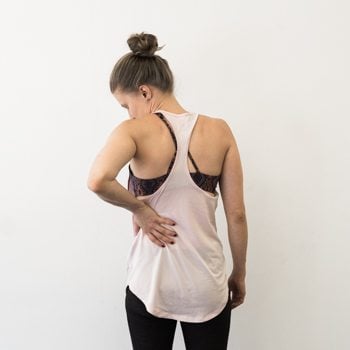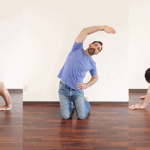Contents: How the Spine Works / What Can Go Wrong? / Resources to Fix Your Back
Our backs are amazing, complex structures.
 The spine helps us carry heavy loads, bend and move in every direction, and because it houses the spinal cord, it’s involved in helping us process the sensations that allow us to connect with the world around us.
The spine helps us carry heavy loads, bend and move in every direction, and because it houses the spinal cord, it’s involved in helping us process the sensations that allow us to connect with the world around us.
But we don’t really think much about our backs until something starts to hurt.
And at that point, we become hyper aware of just how much we rely on the joints, ligaments, and muscles of our spines in our daily activities.
In this post, we’ll shed some light on this complicated structure, to give you insight into what our backs are capable of, and what can happen when things go wrong. And we’ll also share some recommendations on how to maintain and improve your back flexibility and strength.

Download our Back Stretching Routine
Get the proven 6-stretch sequence that’s helped thousands of people loosen up stiff backs, yours free.
The Nuts and Bolts of the Spine
 It would be far too complicated–and would make for far too long of an article!–to describe every structure and function in the whole back. And, really, for most people, knowing all the details of spinal anatomy is not necessary for understanding its basic functions.
It would be far too complicated–and would make for far too long of an article!–to describe every structure and function in the whole back. And, really, for most people, knowing all the details of spinal anatomy is not necessary for understanding its basic functions.
So, we’ll just go over the essential aspects of how the spine works.
The spine is separated into four basic regions:
- 7 Cervical vertebrae (neck)
- 12 Thoracic vertebrae (upper and mid back)
- 5 Lumbar vertebrae (low back)
- Sacrum (between low back and tailbone)
We’ll focus primarily on the thoracic and lumbar regions of the spine, since those regions comprise the bulk of what we tend to think of as the “back.” For help with issues in the neck, see this article.
The thoracic spine attaches to the ribs and acts as a transition point between the neck and the low back. It is responsible for helping us in full body twists, turns and sidebends.
Flexion and extension (forward and backward bending) are the primary functions of the lumbar spine, so good flexibility in these actions is important for keeping this region of the spine moving well.
One of the most complex aspects of the spine–particularly the mid and low back–is that it has to be flexible enough to move in every direction, while remaining rigid enough to transfer heavy loads through our arms and legs, whether we are sitting, standing, or lying down.
Part of what makes this possible is the system of attachments of the vertebrae to the various ligaments and muscles in the region.
- The thoracic spine has to be a supportive and mobile structure for the upper extremities. There are direct connections to the ribs through joints and ligaments, and indirect muscular and fascial attachments to the shoulder blades and arms.
- In the lumbar spine, mobility is, of course, very important, but not as much as the stability necessary to transfer force well from the hips and even the upper back and arms. This is most apparent in carrying and lifting activities.
When the spine is flexible and strong, it becomes a stable base for us to use our arms and hips/legs as effectively as we can for every movement available. When it’s not functioning the way it should (which we’ll address in the next section), that’s when you can run into trouble with even simple tasks like bending down to pick up a pen off the ground.
What Can Go Wrong in the Spine?
 Clearly, the spine is quite complex, and as we know, the more complex something is, the more things can go wrong with it. The spine is no exception.
Clearly, the spine is quite complex, and as we know, the more complex something is, the more things can go wrong with it. The spine is no exception.
Before we get into the meat here, I just want to remind you that the information in this article is no substitute for being seen by a professional in-person if you have ongoing issues–particularly related to pain or weakness. Cool, let’s continue.
There are 3 main categories of issues people experience in the back:
- Mobility limitations
- Strength limitations
- Pain
We’ll go into each of these in more detail, but quite a bit of issues in the back can be chalked up to the prolonged static postures the vast majority of us are in when we sit. The answer, of course, is not to quit your job and donate all the chairs in your house to Goodwill, but rather to be aware of these issues and work on addressing them.
There are also some issues that come into play with posture and how we hold ourselves throughout the day. Click here to learn more about how we approach and address posture.
Got a Tight Back?
 Mobility restrictions are super common in the thoracic and lumbar spine.
Mobility restrictions are super common in the thoracic and lumbar spine.
Because we often sit with our bodies rounded forward, extension (backbending) becomes a big challenge, this along with tightness in the hips can interfere with our spinal health.
This lack of mobility is worsened after an injury, and can result in very limited movement.
In this case, even the simplest rehab or yoga exercises can have such a profound impact on movement limitations. I’ve seen people come into the clinic barely able to move and with some gentle rehab and exercise, they can walk out nearly normal.
Even without an acute injury, though, some people live too long in such a restricted range that their bodies overreact to strain and stress, whereas a more conditioned and mobile back would have better handled the pressure and tension. The adage, “an ounce of prevention is worth a pound of cure” holds true here.
Trouble Building Strength in the Back?
 The rounded back posture commonly found in the seated position, where your shoulders flare out and roll forward, puts you in poor alignment to use your back (and neck and shoulder) muscles correctly.
The rounded back posture commonly found in the seated position, where your shoulders flare out and roll forward, puts you in poor alignment to use your back (and neck and shoulder) muscles correctly.
In this position, the muscles between and surrounding your shoulder blades (rhomboids, upper, middle, and lower traps and the rotator cuff) become not just posturally weak, but weak in general. The deep and intermediate muscles of the spine, which act as stabilizers and support, will also weaken from long hours of sitting and slumping.
This makes it difficult to build strength in the back, and over time, the weak muscles will lead to poor function or inability to perform well in the activities you want and need to do.
There are many ways to strengthen the back, from weight training to bodyweight leverage exercises. We need the stimulation of active back work in a variety of activities. Lifting, carrying, and bending in all planes of motion help to improve and maintain back strength.
Back Pain?
 We’ve all heard lots of different ways to describe back pain. Words like “pinched,” “aching,” “sharp,” “jammed,” and even “out”–as in “my back is out”–are all parts of normal conversations amongst high level athletes and garage gym trainees alike.
We’ve all heard lots of different ways to describe back pain. Words like “pinched,” “aching,” “sharp,” “jammed,” and even “out”–as in “my back is out”–are all parts of normal conversations amongst high level athletes and garage gym trainees alike.
There are quite a few pain generating structures in this region: ligaments, tendons, discs, muscles, and joints can all cause separate and combined issues.
You could try to narrow it down to one particular part to blame, but that’s a tricky subject.
The connectedness and adaptability of the body points to more than one cause, even in what seems like a cut and dried injury to a specific area.
Rather than focus on a particular area–not including issues after surgeries–it’s best to work on everything in a “wholistic” way. Pain occurs not just in one body part, but also as our body’s adaptation in reaction to an injury or trauma.
Pain is a complicated issue and anybody selling you the “one secret way” to deal with it is either deluded or predatory.
How to Fix What’s Ailing You
 Tightness, pain, weakness, or other issues throughout the spine are ubiquitous nowadays, since we spend so much of our time in a seated position and not much time moving our spines through their full ranges of motion.
Tightness, pain, weakness, or other issues throughout the spine are ubiquitous nowadays, since we spend so much of our time in a seated position and not much time moving our spines through their full ranges of motion.
But rather than drastically change your lifestyle–which is unrealistic for most of us–you can work some simple exercises into your daily routine to combat these issues.
Here are some resources to help you work on what you need to. You’ll notice these aren’t only focused on the back because, as we’ve mentioned, everything is connected. It’s nearly impossible to isolate issues in the back without also focusing on issues in the neck, hips, or shoulders.
- Back Stretching Routine–This is a gentle routine that’s best for beginners or those coming back from an injury.
- Forward Bending and Backbending Flexibility–This routine will help you take your spine through its full range of flexion and extension, and can help you go deeper into your spinal flexibility.
- Neck Strength and Mobility–If you have tightness or pain in your neck, this is a good routine to work on improving function in the upper part of your spine.
- Hip Mobility Routine–This 8-step routine will help open up the hips, which can be tied to tightness in the low back.
- Shoulder Mobility Routine–If you have restrictions in your mid and upper back, working on opening up your shoulders can be quite helpful.
Develop Freedom of Movement
Up your performance in any activity by improving your flexibility right where you need it. GMB Mobility’s smart training method means better results faster, so you can do more of what you love.




